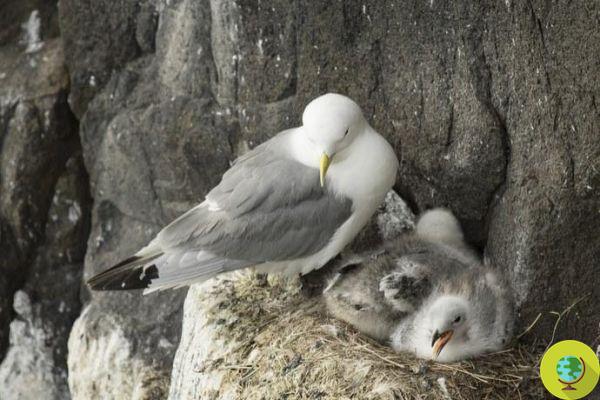
There are traces of plastic and chemical additives in the eggs of birds living in the Arctic. This was revealed by a new study conducted by the Canadian Wildlife Service, according to which eggs laid by northern fulmars on Prince Leopold Island in the Canadian Arctic tested positive for phthalates.
There are traces of plastic and chemical additives in the eggs of birds living in the Arctic. This was revealed by a new study conducted by the Canadian Wildlife Service, according to which eggs laid by northern fulmars on Prince Leopold Island in the Canadian Arctic tested positive for phthalates.
Plastic is really everywhere. Its presence in the North Pole had already been ascertained, as well as in the Mariana Trench. Remote places but not immune to the invasion of our garbage.
But the study conducted by Canadian scientists for the first time found phthalates in the eggs of some Arctic birds, the northern fulmars. These contaminants could come from the plastic debris that unsuspecting animals ingested while searching for fish, squid and shrimp in the Lancaster Strait, at the entrance to the Northwest Passage, between Devon and Baffin Island.
Fulmars are large albatross-like birds that fly low above the waves in search of food. They can live for 40 years or more and spend most of their lives feeding in the sea, returning to their nests only to reproduce. In their stomach there is an oily liquid that they use as a defense weapon, throwing it back on invaders who threaten their nests. Scientists believe that the phthalates found their way into the fluid, and from there they passed into the bloodstream and subsequently into the eggs that the females were producing.
Tests by Jennifer Provencher of the Canadian Wildlife Service revealed that mothers passed a cocktail of contaminants to their unborn chicks. "It's really tragic", he said at a meeting of the American Association for the Advancement of Science in Washington DC. "That bird, from the very beginning of development, will have the contaminants in its body."
According to Provencher, finding the additives in bird eggs in such a pristine environment is worrying. Nordic fulmars, for their part, are among the birds that come into less contact with plastic than their peers.
Phthalates have notoriously harmful effects. These chemicals alter hormones and the endocrine system and have already been linked to birth defects, fertility problems and a host of metabolic diseases. Many phthalates have been banned in children's toys for safety reasons.
Other tests found traces of plastic contaminants in the kittiwake eggs collected from the same nesting sites. The eggs tested positive for SDPA and UV BZT, which are added to plastics to prevent them from degrading and losing their color when exposed to sunlight.
Scientists now want to look for plastic contaminants in the eggs of other bird populations that ingest larger amounts of plastic debris.
"We need to check if they have the same chemicals or even higher levels," Provencher said.
READ also:
- Ocean trash: Even the Arctic is flooded with our dirty plastic
- The Arctic is chock full of microplastics: 12000 particles in a liter of ice
- The deepest plastic bag in the world, found in the Mariana Trench
Francesca Mancuso


























